Hello and welcome to ‘Focused on Feld’. In this series of reviews, I am working my way backwards through Stefan Feld’s entire catalogue. Over the years, I have hunted down and collected every title he has ever put out. Needless to say, I’m a fan of his work. I’m such a fan, in fact, that when I noticed there were no active Stefan Feld fan groups on Facebook, I created one of my own.
Today we’re going to talk about 2022’s Marrakesh, his 36th game.
In 2005, Queen Games published Feld’s very first title, Roma. Prior to 2021, he published an additional four titles under their banner. Stefan Feld has always had an association with Queen Games, but 2021 really solidified it. In 2021, Kokopelli hit the shelves and that was followed by the first of two Kickstarter campaigns for the Stefan Feld City Collection (SFCC)—a series of redesigned, reimagined, rethemed, and reimplemented titles from Stefan Feld’s past, as well as a brand new game, Marrakesh, the subject of this review. In all, there are currently a total of four games in the SFCC with another two due to hit Kickstarter soon, both implementations of some of his earlier works, and two more after that which Queen Games has only hinted at. If this is indicative of a pattern, I think it’s reasonable to expect that either game seven or eight will be something brand new. Regardless, there are exciting things on the horizon.
Overview
An action selection game driven by a “cube” tower, like many of Stefan Feld’s designs, Marrakesh is rife with victory point scoring opportunities.
Each player begins a round with a set of twelve different colored, wooden cylinders and three assistant pawns. Each color corresponds to one sector of the players’ Player boards. Each of these sectors is affiliated with a specific action that takes place whenever an assistant is assigned to it.
At the start of a player’s turn, they secretly select three of the cylinders hidden behind their screen. After revealing their choice, they place their assistants in the sectors whose color matches their selection. Then, the cylinders are gathered together and dropped into the tower. The cylinders that emerge at the bottom are drafted one set at a time and added to the player’s boards, where their presence boosts the effectiveness of the associated actions.
After drafting all the cylinders, players take turns removing their assistants and performing the associated actions. This cycle continues until the players have gone through their entire collection of cylinders a total of three times. Then the game ends, the final scores are tallied, and the person with the highest total wins.
Of course, this is a very high level overview. If you think you’ve heard enough and just want to know what I think, feel free to skip ahead to the Thoughts section. Otherwise, read on as we discuss how Marrakesh is played.
Just a note before we begin: this review is written with the standard version of the game in mind. With the deluxe edition, the game play is the same, but the components may differ from what is described here.
Setup
A game of Marrakesh is setup thusly:
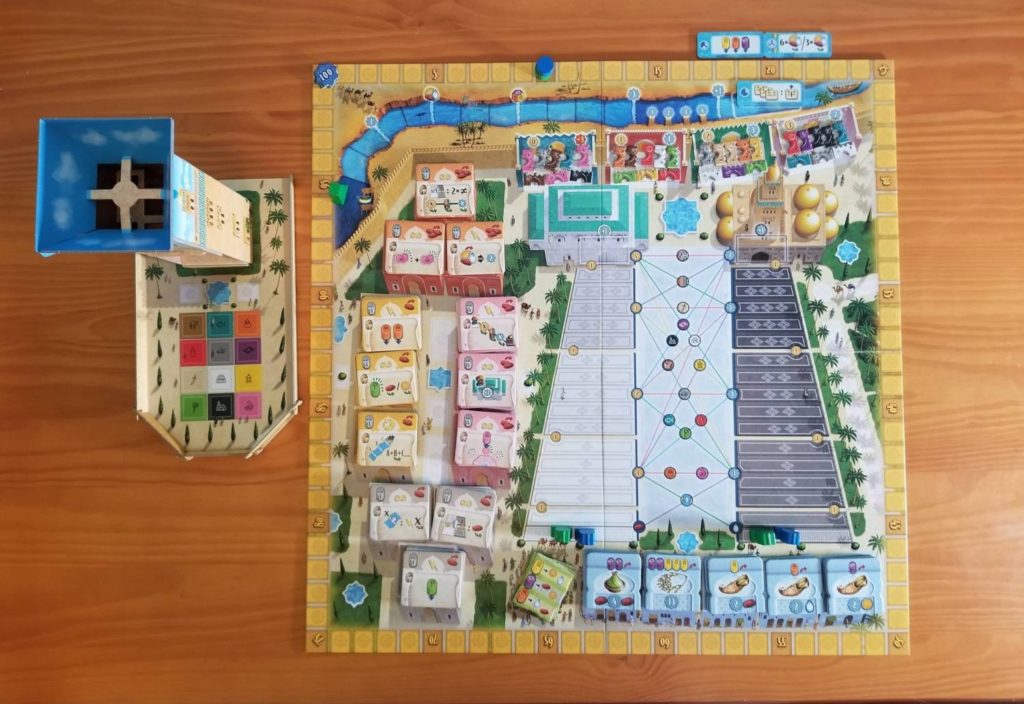
The main board is set out and populated with the various tiles: grey, pink, yellow and orange Scrolls; Luxury Goods; and three randomly selected Exchange Offices. These are all arranged across their marked spaces in face down stacks of the same size, with the top of each turned face up. The gates are placed into the bag, which is shaken thoroughly, and eight are drawn and placed on each of the Workshop spaces. Then, the River tiles are divided by season and one is drawn randomly for each of the three seasons. These are placed along the top of the main board.
Each player receives a Player board, six randomly selected Oasis tiles, a randomly selected Audience disk, one water, one date, and one gold. Place the cylinders (called ‘keshis’) into the bag and give it a good shake. Then, depending on the player count, a number of these are drawn and placed into their locations across the player’s Oasis storage on their Supply board.

Each player also receives a full retinue of the twelve keshis (kept hidden behind their Player screen), three randomly assigned Provision tiles (placed face down), a Scoring marker, and six Assistants. Of these, one Assistant is placed on each of these spaces on the main board: at the start space of the river; at the bottom step of the Palace staircase; and the bottom step of the Mosque staircase. Their Scoring marker is placed on the 10 space on the Scoring track.
Everything else—the supply of water, dates, and gold—is placed within reach of all players, along with the tower. Randomly select a Start player and give them the Season and Round trackers. Now, you’re ready to begin.
Anatomy of a Round
Marrakesh is played over the course of three seasons, each consisting of four rounds. At the start of a season, each player must select one of their Provision tiles to turn face up.
As a round begins, each player will select three of the keshis from behind their screens and hide them in their hand. Once all players have made their selections, the selections are revealed, and the players place their remaining three Assistants in the sectors of their Player board matching the colors of the selected keshis (red keshis are wild and the matching Assistant can be placed anywhere there isn’t another Assistant assigned to). Then, the keshis are all collected together and dropped into the tower.
The tower has shelves inside of it that are designed to catch and prevent some keshis from falling out. The ones that do fall out are then arranged by color and players will take turns drafting from these collections. As a player drafts keshis of a certain color, they get placed onto that player’s board in the matching sector. And, once every keshi has been drafted, the next phase of the round begins.
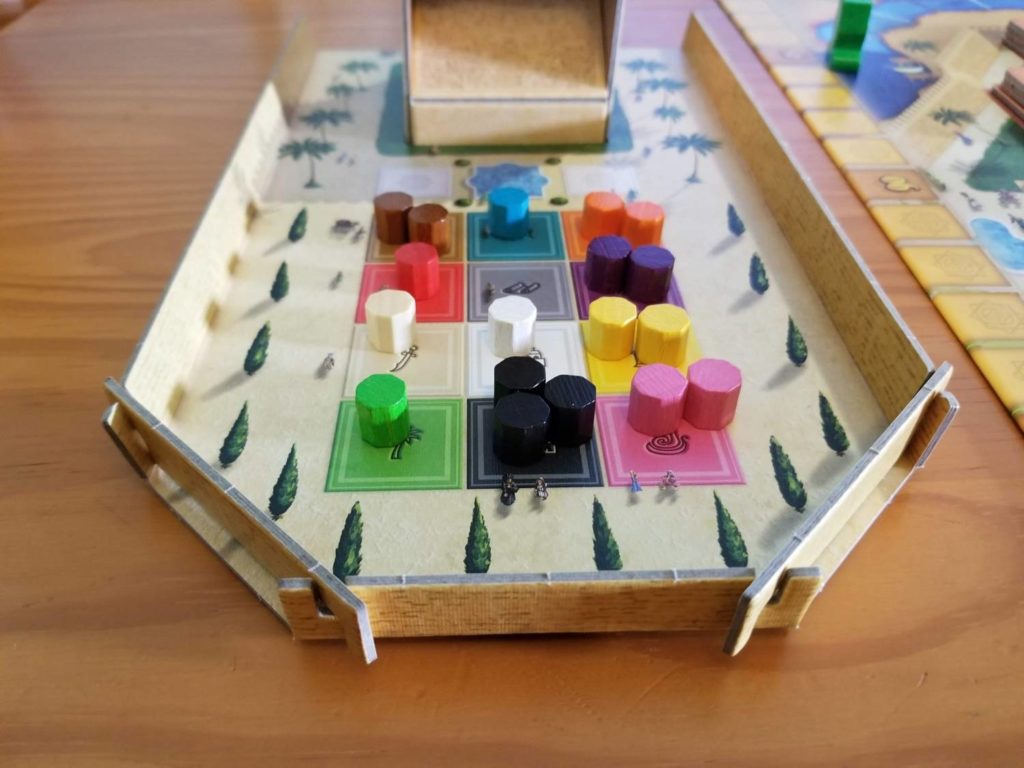
During this phase, the players go in turn performing the actions of each sector of their board where they have placed one of their Assistants. After all players have performed their actions, an end-of-round phase will occur. I’ll briefly go over each of the colors and their associated actions in a later section.
In the end-of-round phase, the Round marker passes to the next player and a new round begins. After four rounds, an end-of-season phase occurs. Players are awarded bonuses based on their position on the River track and their boats are returned to the starting positions. Each player must pay all the resources shown on every visible Provision tile in their area. If they cannot pay any portion of that total, they lose all of their resources as well as a number of victory points equal to the negative value printed on each Provision tile. Then, new Luxury Goods, Scrolls, as well as a new Exchange Office are revealed, and the Season tracker and Round tracker are passed to the player to the left of the current holder of the Season tracker and the next season begins.
The Actions in Brief
Each sector consists of a total of nine spaces that are capable of holding one keshi each: eight matching the color of the sector, and a single red space. Filling up entire sectors can net you a lot of points at the end of the game during final scoring.
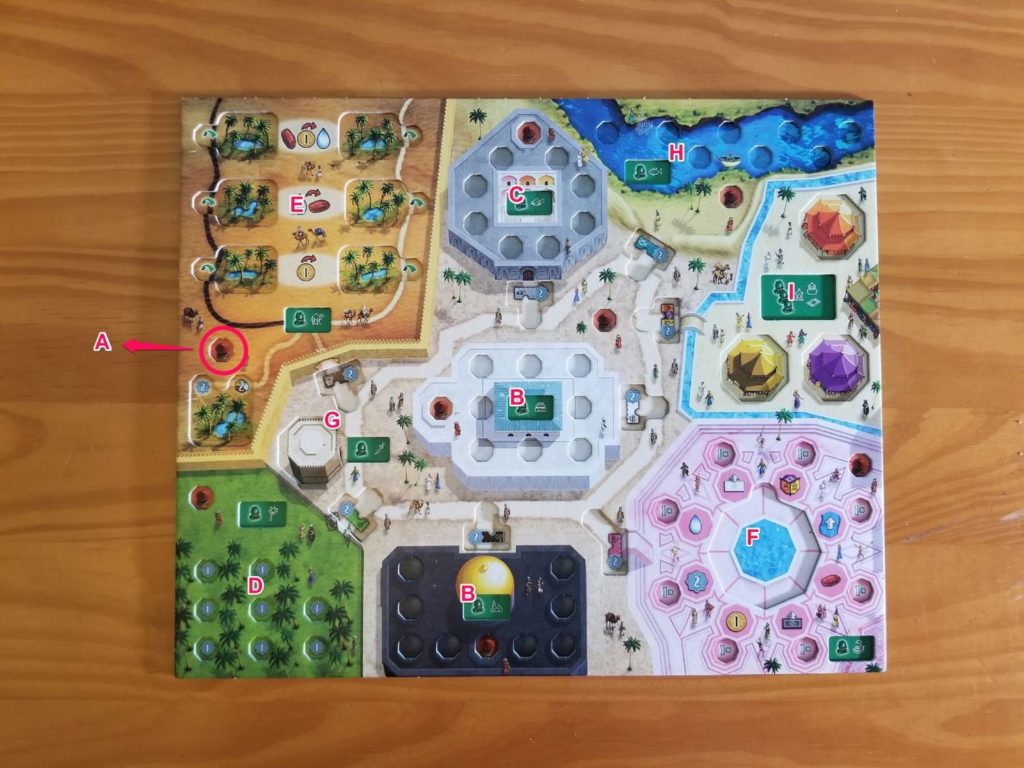
A. Red: Red keshis are water vendors. Performing an action in a sector containing a water vendor will earn you a water resource in addition to whatever the action provides.
B. Black/white: Move the associated pawn up the associated track a number of times equal to the number of keshis present in the area. Moving up these tracks unlocks valuable bonuses along the way.
C. Grey: Purchase Scrolls based on how many keshis you have here and how many dates you pay. There are many Scroll effects such as scrolls that gain you instant keshis/resources or scrolls that make other actions far more beneficial than they would normally be.
D. Green: Earn a victory point as soon as a keshi is placed in this sector. Performing the action earns you dates equal to the number of keshis present in the sector.
E. Brown: Placing a keshi will uncover one of the face down Oasis tiles. Performing the action will allow you to pay resources in order to claim these tiles and place them into your Oasis storage, which will unlock bonuses along the way.
F. Pink: Placing a keshi will earn you a one-time reward. Performing the action will allow you to turn the Audience disk (which is placed here during setup) a single time and then earn bonuses based on the result.
G. Neutral: Purchase and place a gate from the Workshop. You will earn (or lose) victory points depending on where you purchased the gate from. Placing a gate whose color matches the color of the sector the gate is placed next to earns you extra victory points. And you get a free keshi matching the color of the gate that you placed regardless of whether the color matched.
H. Blue: Move up the river one space for each keshi here. You can extend the distance moved by paying fish.
I. Yellow/Orange/Purple: Use the keshis placed here to purchase Luxury Goods which are worth victory points and may earn you resources. You can also trade keshis to the Exchange Office tile and earn whatever the tile dictates (trading a purple keshi for a water and a date, for instance).
End Game and Scoring
Marrakesh ends once the third season is complete. Each completed sector is worth ten points. Each player can score up to three of the Oasis tiles in their oasis storage. And players earn points for leftover resources. Add these points to any points earned over the course of the game to determine the winner.
Thoughts
While I’m always excited to see a new title from Stefan Feld, I must admit I was feeling a bit lackluster about the Stefan Feld City Collection. It’s difficult to get excited about revamped versions of older games you’ve come to know and love. I backed the campaigns because I’m a collector, but I wasn’t particularly excited about doing so. That was until I saw Marrakesh. When I saw Marrakesh, I knew I needed it in my life. Its component-laden, cube tower driven glory called to me from the Kickstarter page and I wasted no time backing it. Then the wait began. I waited.
And waited.
And waited.
I waited until it became almost interminable. Would Queen Games ever deliver? The campaign for games one and two had a scheduled fulfillment date of June 2021 and games three and four were scheduled for a June 2022 fulfillment. And here it was, November of 2022. Just when I was beginning to feel like none of these games would ever see the light of day, it happened: I received a shipment notification out of the blue. All four games were on their way. It was a reality! Needless to say, when Marrakesh finally arrived, I tore into it like a kid on Christmas morning.
It was well worth the wait. Marrakesh was, hands down, one of the best games I had the opportunity to play in 2022.
Everything about it is like a finely tuned symphony. At first, all is chaos, like the musicians warming up, but more redolent of the end of a Beatles tune. Then, all goes quiet. Faintly, just at the edge of hearing and growing subtly louder, the game’s mechanics drop in one at a time. First, the hidden selection followed by the reveal. Then that’s joined by the cylinder drop. And then the draft. AND THEN the action selection. AND THEN COMES THE PERFORMANCE of the actions themselves. AN EXPLOSION OF BONUSES! A RAIN OF VICTORY POINTS! YOU’RE IN IT NOW! THE PACE PICKS UP! YOUR HEART IS RACING! EACH REVISITING OF THE BEGINNING OF THE ROUND BRINGS WITH IT A NEW LEVEL OF EXCITEMENT!! AND THEN… A LESSENING of the pace. The game has ended. The scores are tallied. And, regardless of the outcome, you leave the game wholly impressed. You’ve borne witness to something magnificent.
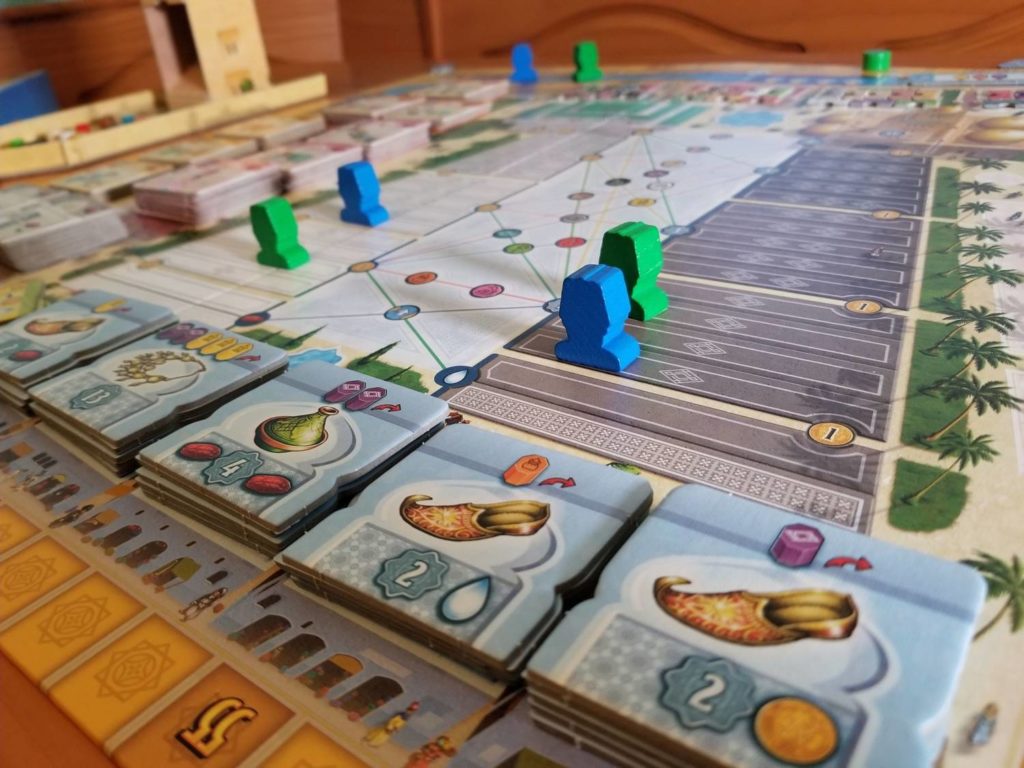
Marrakesh is a game of tough choices. Not everything is going to break your way. Your hopes to pick up a particular cylinder pair will be dashed. Someone is going to take what you were hoping for, so it pays to have a back up plan. And that means your initial cylinder choices are important. Should you load up the tower with things you want to do? Or should you load it up with maybe one thing and a thing or two that you know your opponents are likely to want to do so that you’ll have a better shot at getting what you really wanted? Sometimes it’s a no brainer. Sometimes you’re going to be getting first pick, but you can rest assured your opponents are performing the same calculations in their head.
Marrakesh is also a game of exciting outcomes. As the game begins, the gears grind slowly. You haven’t got many keshis deployed, so the outcomes of your chosen actions aren’t exactly exciting. But as the keshis in each sector multiply, those actions become bigger and better. In one game that I played, I was able to obtain a Scroll that awarded a free Scroll from another stack which, in turn, rewarded me with a free Oasis and the Oasis that I chose was one that I’d uncovered that awarded me points at the end of the game based on how many Scrolls I’d collected. There’s no denying the awesome feeling that washed over me when I was able to pull that off.
It Felt Great.
The set up and rules teach can be quite a bear, so be prepared. Practice the teach ahead of time if you’re doing the teaching. Put your players to work during the setup. As you parcel out the various components, call them by their names so your players can familiarize themselves with them. Trust me. You’ll be glad you did. It’s a big game. Perhaps Stefan Feld’s biggest game yet. And it’s got a lot of big ideas.
If I had to come up with something negative about the game, that would be it. At times, it feels like maybe it has a few too many big ideas. Maybe a color or two could have been cut out of the final design. Maybe that tuba doesn’t belong in the middle of the orchestra. It can feel a bit much, but not to the point of being off-putting. I’ve played with people that just generally felt like there were one or two things too many to keep track of, but they were all eager to play it again.
They’re not alone on that count. I’m glad I can break out Marrakesh and play it whenever I want. And I want to play it all the time. Is it my favorite Feld ever? It is not. That position is still held by The Oracle of Delphi. In my review of Bonfire, I declared that Bonfire had entered my list at number two. But that was then and this is now.
Bonfire, welcome to number three. That second place spot belongs to a new game now.




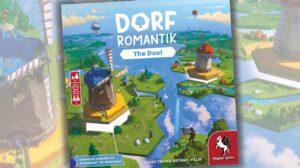







Add Comment